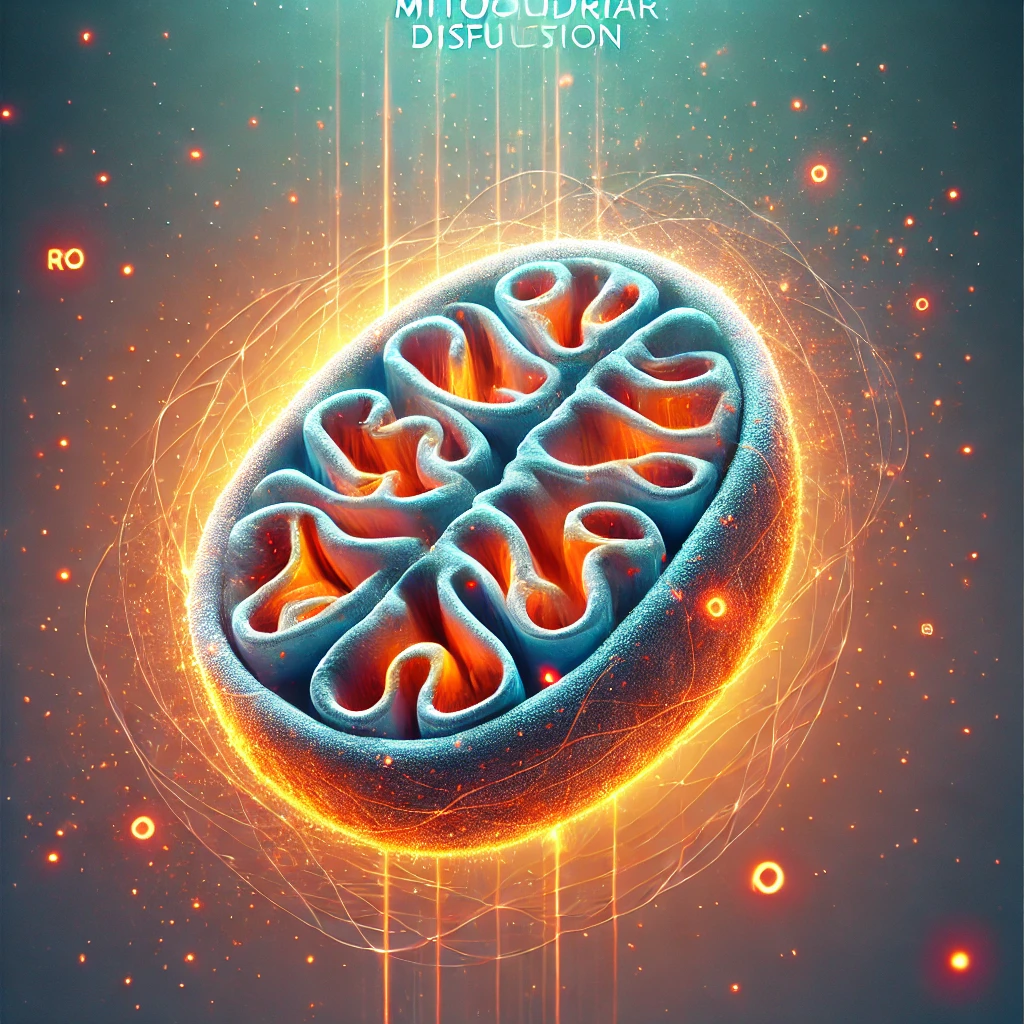Mitochondria, often referred to as the cell’s powerhouses, are essential organelles responsible for generating energy in the form of ATP via oxidative phosphorylation. Beyond energy production, they play critical roles in regulating cellular metabolism, signaling, and apoptosis. However, mitochondrial function declines with age, contributing significantly to cellular dysfunction and aging-related diseases. This article explores mitochondrial dysfunction, its underlying causes, and potential strategies for mitigation.
What is Mitochondrial Dysfunction?
Mitochondrial dysfunction refers to the decline in mitochondrial performance characterized by:
- Reduced ATP Production: Impaired oxidative phosphorylation decreases cellular energy supply.
- Increased Reactive Oxygen Species (ROS): Mitochondria generate ROS as byproducts of energy production. With aging, ROS levels rise due to inefficiencies in the electron transport chain, causing oxidative damage to lipids, proteins, and DNA.
- Mitochondrial DNA (mtDNA) Damage: Mitochondrial DNA is particularly vulnerable to damage from ROS, leading to mutations that further impair function.
- Altered Mitochondrial Dynamics: The balance between mitochondrial fusion and fission becomes disrupted, compromising mitochondrial quality control and adaptability.
While mild mitochondrial stress can trigger protective adaptive responses (hormesis), chronic or severe dysfunction promotes a pro-aging environment, characterized by:
- Accumulation of damaged proteins and organelles.
- Inadequate energy supply for cellular processes.
- Increased oxidative stress and inflammation.
Potential Interventions for Mitochondrial Health
Efforts to address mitochondrial dysfunction focus on enhancing mitochondrial quality, reducing oxidative damage, and improving energy efficiency. Below are evidence-based strategies:
1. Exercise and Hormesis
- Endurance Training:
- Regular aerobic exercise stimulates mitochondrial biogenesis through the activation of PGC-1α (peroxisome proliferator-activated receptor gamma coactivator 1-alpha), a key regulator of mitochondrial growth and function. Improved mitochondrial quality can enhance energy production and reduce oxidative stress.
- Mild Stressors (Mitohormesis):
- Cold Exposure and Sauna: Controlled exposure to mild stressors can activate adaptive pathways, improving mitochondrial resilience. These interventions promote mitochondrial turnover and the activation of stress-response proteins.
2. NAD⁺ Restoration
- NAD⁺ Precursors:
- Compounds like nicotinamide riboside (NR) and nicotinamide mononucleotide (NMN) restore levels of NAD⁺, a crucial coenzyme for mitochondrial function.
- NAD⁺ supports the activity of enzymes like sirtuins and PARPs, which maintain mitochondrial and nuclear health by regulating DNA repair and cellular stress responses.
3. Mitochondrial-Targeted Antioxidants
- MitoQ and SkQ1:
- These specialized antioxidants accumulate within mitochondria to neutralize ROS at the source, reducing oxidative damage without disrupting ROS-dependent signaling.
- Coenzyme Q10 (CoQ10):
- As a key component of the electron transport chain, CoQ10 supplementation can improve electron transport efficiency and reduce ROS production in certain individuals.
4. AMPK and mTOR Modulation
- AMPK Activation:
- AMPK (AMP-activated protein kinase) promotes energy balance by stimulating catabolic processes and mitophagy—the selective degradation of damaged mitochondria.
- Metformin: A diabetes medication, metformin activates AMPK and improves mitochondrial turnover and efficiency.
- mTOR Inhibition:
- The mechanistic target of rapamycin (mTOR) suppresses autophagy when overly activated. Rapamycin, an mTOR inhibitor, enhances mitophagy and shifts cells towards a maintenance mode, supporting mitochondrial health.
Challenges and Future Directions
Despite significant advances, challenges remain in addressing mitochondrial dysfunction:
- Inter-individual Variability: Responses to interventions like supplements or exercise differ based on genetics, age, and health status.
- Long-Term Safety: Pharmacological agents like rapamycin have potential side effects that require careful management.
- Precision Medicine: Developing targeted therapies to address specific mitochondrial defects is an area of ongoing research.
Emerging technologies, such as mitochondrial replacement therapy and precision gene editing (e.g., CRISPR), hold promise for tackling mitochondrial dysfunction at its root.
Conclusion
Mitochondrial dysfunction is a hallmark of aging, contributing to cellular decline and age-related diseases. Interventions like exercise, NAD⁺ restoration, targeted antioxidants, and metabolic modulation offer practical approaches to support mitochondrial health. As research continues, these strategies may pave the way for novel therapies to enhance healthspan and mitigate the effects of aging.



